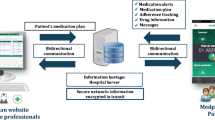Abstract
Medication dosing errors can greatly reduce HIV treatment effectiveness as incorrect dosing leads to drug resistance and non-adherence. In order to dose correctly, HIV therapy providers must balance several patient characteristics such as renal functions and weight. In developing countries and other resource-limited settings, dosing errors are more likely because treatment is provided by mid-level providers with only basic training in HIV therapy. These providers also typically lack electronic tools informing medical decisions. Widespread adoption of mobile phones in developing nations offers an opportunity to implement a point-of-care system to help providers reduce dosing errors. We discuss the development of the mHIV-Dr system prototype using the new Android mobile platform. mHIV-Dr is being designed to provide dosing recommendations for front-line providers in developing countries. We also discuss the additional challenges in the implementation of the mHIV-Dr system in a resource limited setting.



Similar content being viewed by others
References
Faragon, J. J., and Lesar, T. S., Update on prescribing errors with HAART. AIDS Read 13(6):268–70, 274–8, 2003.
Hammer, S. M., Eron, J. J., Jr., Reiss, P., Schooley, R. T., Thompson, M. A., Walmsley, S., Cahn, P., Fischl, M. A., Gatell, J. M., Hirsch, M. S., Jacobsen, D. M., Montaner, J. S., Richman, D. D., Yeni, P. G., and Volberding, P. A., Antiretroviral treatment of adult HIV infection: 2008 recommendations of the International AIDS Society-USA panel. Jama 300(5):555–570, 2008.
Sadasivam, R. S., Tanik, M. M., and Willig, J., A conceptual framework for personalized and mobile health care. J. Integr. Syst. Des. Process 12(2):31–41, 2009.
Willig, J. H., Westfall, A. O., Allison, J., Van Wagoner, N., Chang, P. W., Raper, J., Saag, M. S., and Mugavero, M. J., Nucleoside reverse-transcriptase inhibitor dosing errors in an outpatient HIV clinic in the electronic medical record era. Clin. Infect. Dis. 45(5):658–661, 2007.
Kumar, P., Providing the providers—remedying Africa’s shortage of health care workers. N. Engl. J. Med. 356(25):2564–2567, 2007.
World Health Organization (2006) Treat, train, retain. The AIDS and health workforce plan. Report on the consultation on AIDS and human resources for health
World Health Organization. Task shifting: Rational redistribution of tasks among health workforce teams: Global recommendations and guidelines. 2008; Available from: http://www.who.int/healthsystems/TTR-TaskShifting.pdf
Baker, V., and Copping, M., A pilot study exploring the clinical benefits when using a Mobile Clinical Assistant, the Motion C5 in medical wards. Stud. Health Technol. Inform. 146:121–125, 2009.
Romoren, M., Hussein, F., Steen, T. W., Velauthapillai, M., Sundby, J., Hjortdahl, P., and Kristiansen, I. S., Costs and health consequences of chlamydia management strategies among pregnant women in sub-Saharan Africa. Sex. Transm. Infect. 83(7):558–566, 2007.
Appiah, L. T., Havers, F., Gibson, J., Kay, M., Sarfo, F., and Chadwick, D., Efficacy and acceptability of rapid, point-of-care HIV testing in two clinical settings in Ghana. AIDS Patient Care STDs 23(5):365–369, 2009.
Cusack, C. M., Pan, E., Hook, J. M., Vincent, A., Kaelber, D. C., Bates, D. W., and Middleton, B. In: C.f.I.T. Leadership (Ed.), The Value of Provider-to-Provider Telehealth Technologies. Healthcare Information and Management System Society (HIMSS), 2007.
Ghyasi, A. F., and Kushchu, I. m-Government: cases of developing countries. May 2004, mGovLab, International University of Japan.
Fong, M. W. L., Digital Divide: The Case of Developing Countries. Issues in Informing Science and Information Technology, 6, 2009.
Chang, L. W., Kagaayi, J., Nakigozi, G., Packer, A. H., Serwadda, D., Quinn, T. C., Gray, R. H., Bollinger, R. C., and Reynolds, S. J., Responding to the human resource crisis: peer health workers, mobile phones, and HIV care in Rakai, Uganda. AIDS Patient Care STDs 22(3):173–174, 2008.
Lester, R. T., Mills, E. J., Kariri, A., Ritvo, P., Chung, M., Jack, W., Habyarimana, J., Karanja, S., Barasa, S., Nguti, R., Estambale, B., Ngugi, E., Ball, T. B., Thabane, L., Kimani, J., Gelmon, L., Ackers, M., and Plummer, F. A., The HAART cell phone adherence trial (WelTel Kenya1): a randomized controlled trial protocol. Trials 10:87, 2009.
Bellina, L., and Missoni, E., Mobile cell-phones (M-phones) in telemicroscopy: increasing connectivity of isolated laboratories. Diagn. Pathol. 4:19, 2009.
U.S. President’s Emergency Plan for AIDS Relief (PEPFAR). Latest PEPFAR treatment results. 2008 Sept.; Available from: http://www.pepfar.gov/about/c19785.htm.
IBM Information Center. How SSL provides authentication, confidentiality, and integrity. 2009 [cited 2010 July 18]; Available from: http://publib.boulder.ibm.com/infocenter/wmqv7/v7r0/index.jsp?topic=/com.ibm.mq.csqzas.doc/sy10670_.htm.
Yu, P., Wu, M.X., Yu, H., and Xiao, G.Q. The Challenges for the Adoption of M-Health. in IEEE Int. Conf. on Service Operations and Logistics, and Informatics, 2006.
Stanford, V., Pervasive health care applications face tough security challenges. IEEE Pervasive Comput. 1(2):8–12, 2002.
World Health Organization. Towards universal access: scaling up priority HIV/AIDS interventions in the health sector progress report. 2008 June [cited 2009 July]; Available from: http://www.who.int/hiv/mediacentre/2008progressreport/en/print.html.
The J2EE 1.4 Tutorial. XML and Web Security. 2009 [cited 2006 July 18]; Available from: http://lia.deis.unibo.it/Courses/TecnologieWeb0708/materiale/laboratorio/guide/j2ee14tutorial7/Security7.html#wp498398.
PostgreSQL Documentation. Encryption Options. 2010 [cited 2010 July 18]; Available from: http://www.postgresql.org/docs/8.1/static/encryption-options.html.
Author information
Authors and Affiliations
Corresponding author
Rights and permissions
About this article
Cite this article
Sadasivam, R.S., Gathibandhe, V., Tanik, M.M. et al. Development of a Point-of-Care HIV/Aids Medication Dosing Support System Using the Android Mobile Platform. J Med Syst 36, 1583–1591 (2012). https://doi.org/10.1007/s10916-010-9619-4
Received:
Accepted:
Published:
Issue Date:
DOI: https://doi.org/10.1007/s10916-010-9619-4




